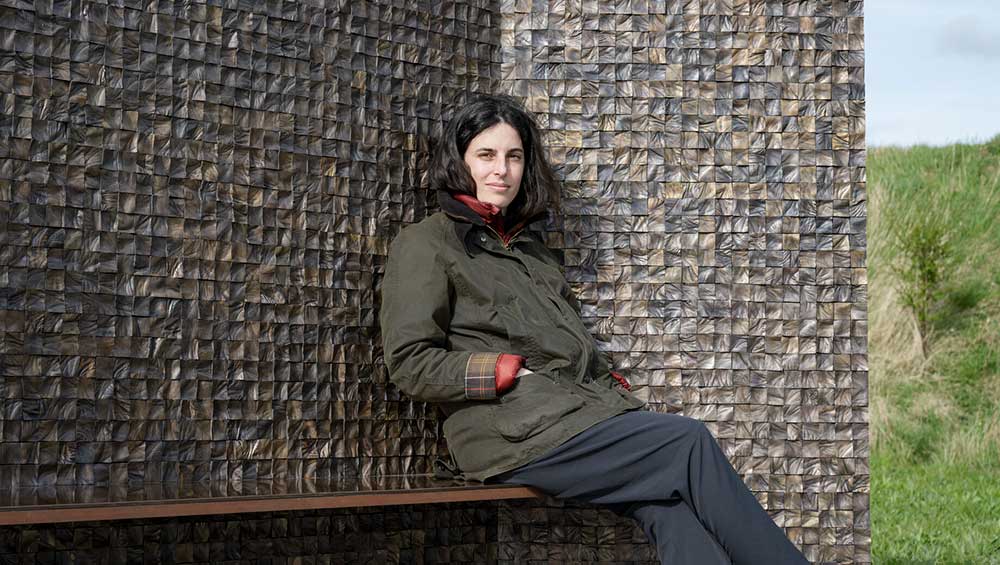
Selva Aparicio with her bronze sculpture At Rest, Nieuwpoort, Belgium, 2024. Courtesy The Artist.
by VERONICA SIMPSON
“This has been one of my busiest years ever,” says Selva Aparicio, as we meet in the “knowledge centre” of one of Belgium’s greatest monuments to the traumas of the first world war, the Cloth Hall in Ypres. The original hall, built in the 13th century when the region was at the heart of a booming textile industry, was destroyed by artillery bombardment, along with much of the town, but was painstakingly reconstructed between 1933 and 1967. Now it houses In Flanders Fields Museum (IFFM), a multi-award-winning exhibition about the experiences, civic and civilian, of the “Great War”. The permanent exhibition is a comprehensive exploration of the political, social and economic context and emotional and physical impacts of that war, providing eyewitness accounts of the traumas and courage of all the individuals and communities involved.
Aparicio is here as the 2024 artist in residence, an annual programme in which artists are invited to respond to the collections and the wider themes of the museum. It has run since IFFM first opened in 1998. (In 2000, Berlinde de Bruyckere became one of the first artists to participate in the programme.)
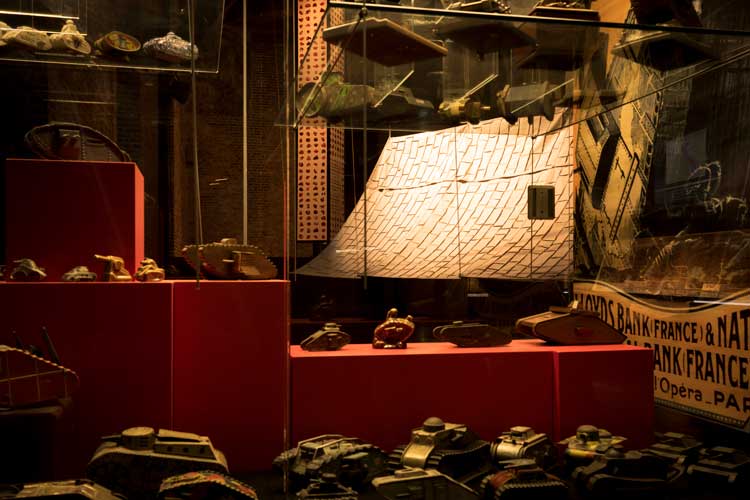
Selva Aparicio. If I write again, 2024. Installation view, In Flanders Fields Museum, The Cloth Hall, Ypres, Belgium. Photo: AS Deldycke.
Two days late to start installing her work, because of two cancelled flights from her home in North America, and with the opening only five days away, Aparicio is generous with her time, happy to talk about her new textile sculpture, which she has assembled in the US over the last three months and brought with her, packed into a modest holdall. It comprises nine canvas panels, each painstakingly assembled and featuring a patchwork of stitched-together prints of letters, photographs, drawings and mementos sent between soldiers and their loved ones – or families in search of their lost sons. They will be assembled into a large tent structure placed at a point in the museum where the narrative shifts from the war itself to the aftermath. The letters will be displayed on the underside of the tent structure so that visitors can read them, and the seams that criss-cross the structure of these panels will be visible on the outside. It is a perfect example of Aparicio’s nuanced but accurate description of her work as “collaborative”: she has spent time with these letters, delved into the lives of their now deceased senders, selected and positioned them with great care; and their narratives are the material that breathes life into her sculpture.
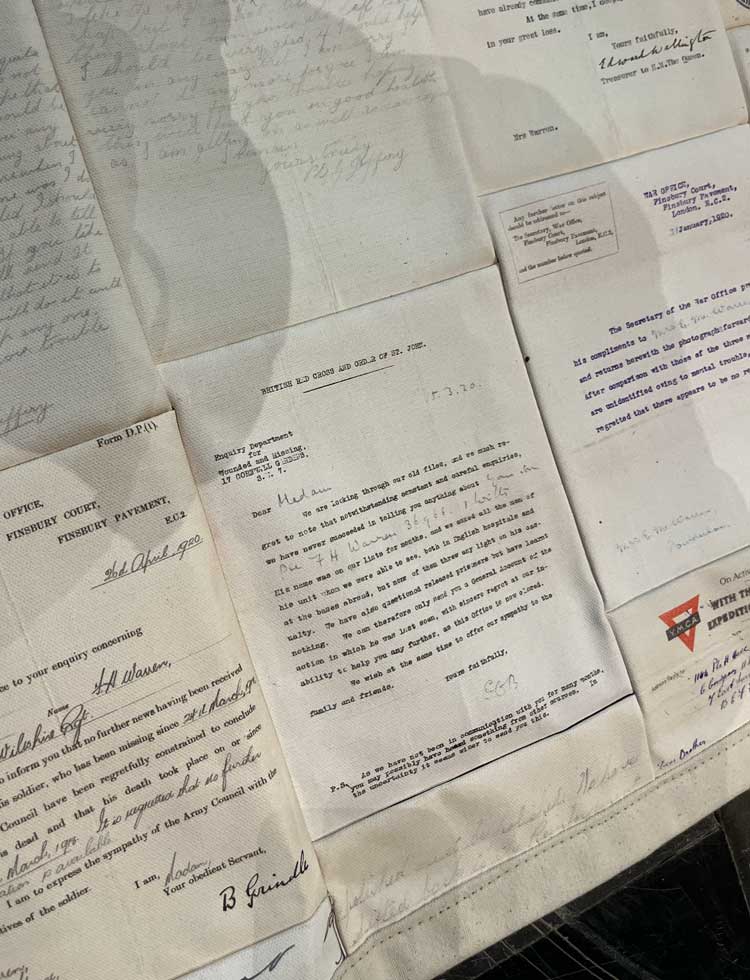
Detail of Selva Aparicio's panels for assembly at In Flanders Fields Museum. Photo: Veronica Simpson.
Aparicio has had a standout year. In spring, she had a major solo show, In Memory Of, at the DePaul Art Museum, in Chicago, the city where she has lived (apart from two years at Yale) since 2012, when she moved there from Barcelona to study. She also completed her first permanent public sculpture as part of Belgium’s Beaufort Triennial. Titled At Rest, it is a hauntingly beautiful bronze bench, looking on to a semi-wild waterfront spot in a recently reclaimed park near Nieuwpoort, its high backrest lined with thousands of cast palm prints taken from local, mostly older people with whom Aparicio workshopped the project. She also received this IFF commission, plus invitations to participate in two shows in Italy. To complicate these international projects, she had to spend most of the summer in the US, as her identity documents were required for the final stages of securing US citizenship. September also saw her relocating her family – her partner and five-year-old son – to upstate New York, where she now has a full-time teaching and research position at Alfred University.
Aparicio grew up in a forest on the edge of Barcelona, in an unorthodox community of artists, musicians, outcasts and mavericks. Here, she saw more than enough evidence of the fragility of life – human, plant and animal. A heightened sensitivity to our brief time on this planet is transmitted in her work through the careful weave and weft or quietly monumental presence of her works, amplified by her chosen materials that might include cicada wings, flowers, seeds, tree parts, and human bodies, living and dead. She cites the resilience, creativity and strength or her mother, a nurse and talented weaver, as a huge inspiration. Though she was not raised with her father, a surgeon, she has clearly been influenced by his practice too. For Entre Nosotros (Among Us) (2017), the artist created an installation of 6in x 6in (15cm x 15cm) concrete tiles cast from nearly 100 human cadavers donated to Yale University for medical research. Aparicio wanted to highlight the physical and spiritual limbo of these bodies, frozen and thus avoiding decay, donated for our benefit.
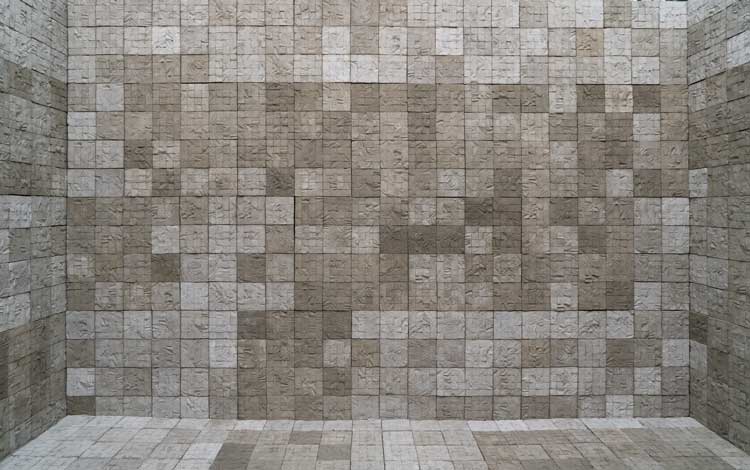
Selva Aparicio. Entre Nosotros (Among Us), 2017. Installation of 6 x 6 in (15 x 15 cm) concrete tiles cast from nearly 100 human cadavers. Photo courtesy Selva Aparicio.
Another work, Ode to the Unclaimed Dead (2022), was triggered by discovering – through drone footage taken and shared during Covid lockdowns - that there is an island off Manhattan, called Hart Island, to which the bodies of the “unclaimed dead” are transported and buried. Aparicio researched the term and found that “unclaimed” in this context doesn’t just refer to people who have no relatives, but also to people whose family cannot afford to bury them. The practice is now under review. But Aparicio’s response was to create an artwork out of a simple plywood coffin, identical to those used for these unfortunate deceased, covering it with dandelion seeds (“symbols of hope”, to Aparicio), and embedding it high on a wall, framed in gold, in a similar manner to the remains of priests in Spanish churches. It was recently acquired for the collection of the Museum of Contemporary Art Chicago.
Aparicio has a BA in fine art from the University of Barcelona, and received a BA in fine art from the School of the Art Institute of Chicago in 2015, and an MFA in sculpture from Yale University in 2017.
Veronica Simpson: Tell me about the work you have done here in Belgium. What was your initial thinking and how has it evolved?
Selva Aparicio: It has changed a lot since the beginning. I was inspired by the whole coast of Belgium and everything I was learning from the Beaufort project. Obviously, there are a lot of outdoor sculptures here that are in commemoration of war. In this, it speaks of a very specific time frame. I was invited here first for the Beaufort Triennial with the curatorial framework A Tapestry of Life. And this theme has almost carried over to this project here in Ypres. I wanted the sculpture itself not to be a foreign object for the people who lived with it. That was important. This museum takes the perspective of the people of the town, not just the soldiers. Everybody’s story matters – that’s a really important part of both works. That’s how I ended up casting thousands of moulds of the palms of people (in Beaufort) as a representation of their life story.
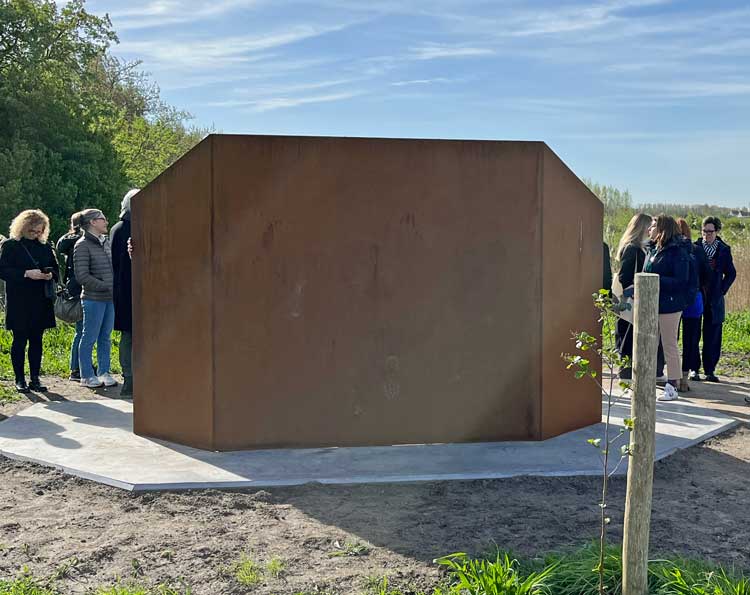
Rear view of Selva Aparicio's bronze sculpture At Rest, Nieuwpoort, Belgium, 2024. Photo: Veronica Simpson.
VS: I was lucky enough to visit that Beaufort sculpture at the opening and loved the remoteness of it, which is a significant part of its charm.
SA: It had to be an intimate space that was more for the locals. It’s permanent. I wanted the element of discovery. When you go there, you see the back of the piece, which mimics the bridge that is next to it. Then you turn around to face it and you see the pixelated palms. Cutting the palms into squares was important for me, like a pixelated map of everyone. And the bench (which curves round) becomes like this embrace. And then the third moment is when you have that behind you, and you sit on it and look forward. There’s this sort of meditation moment, you and nature and these people. At Rest was a good title because you are at rest but, in time, all these people will be “at rest” too.
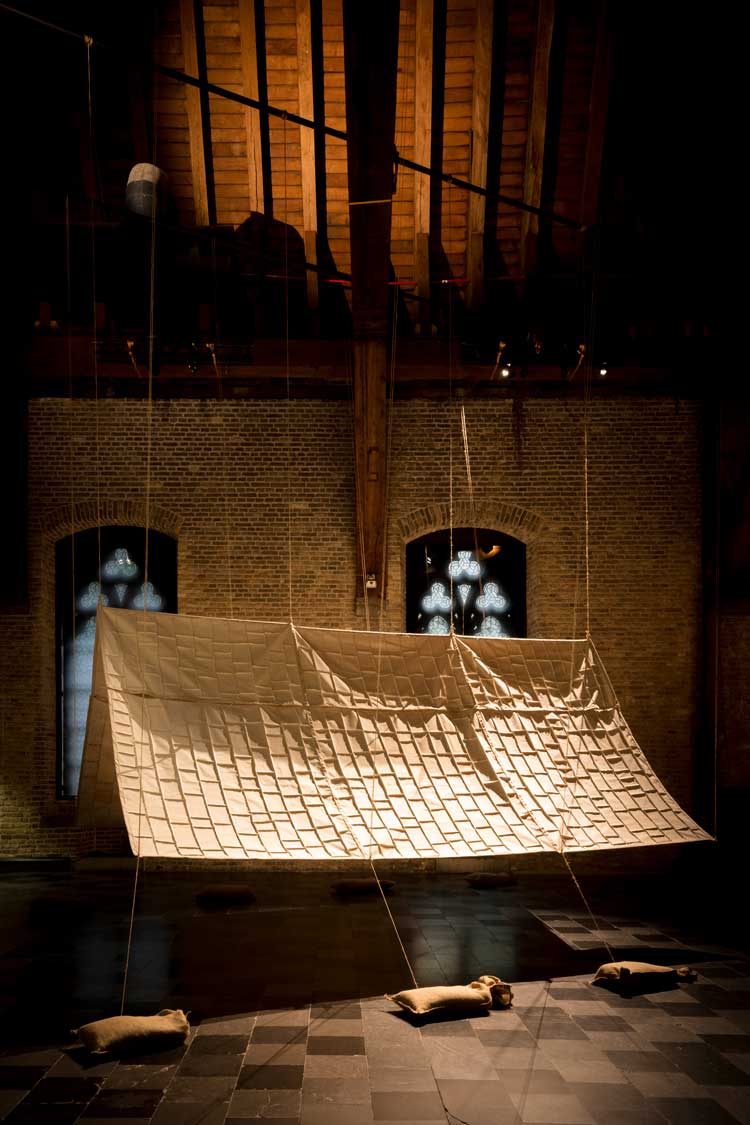
Selva Aparicio. If I write again, 2024. Installation view, In Flanders Fields Museum, The Cloth Hall, Ypres, Belgium. Photo: AS Deldycke.
VS: I love the way your titles work on lots of different levels. They are very eloquent. What about this work in Ypres?
SA: The piece is made with 1,000 letters from the collection. In one of the letters I found this sentence: “If I write again.” And that became the title of the whole constellation. It carries emotion, it also carries the fear that you don’t know what might happen.
VS: What inspired the tent structure of the piece?
SA: There’s a Korean artist I’ve admired since I was a kid, whose name is Do Ho Suh. For one of his main pieces that got him a lot of recognition, he had the idea of wanting to bring his childhood home to the US, so he made it all entirely out of fabric and then packed it in a suitcase and brought it with him. If you see it, it’s unbelievable. The level of detail and craftsmanship is surreal. So, I was here last June, visiting the collection of objects and I saw the original tents from the first world war, and they are still in a pretty good condition. They are 1.6 metres x 1.6 metres - just a piece of canvas, very simple. The size of them shocked me, they are so small. But around the perimeter of the tent, it has buttons and buttonholes, so that if you were to find a colleague, you could connect the tents and make a larger structure. Obviously, it was a functional decision for the design, but I found it super poetic and very beautiful.
So, we had the pixellation of the hands in Beaufort, now we have little squares of the letters on the tents. The tent becomes a screen or portal to this other world.
We have nine tents with nine different stories, which interconnect with the same button design on the edges. It’s not like the At Rest sculpture where the hands become abstract. Here, you know who is who. And once you see them all sewn together into this fabric, and see the different stories at the same time, it gives the idea that this tent could keep growing and growing.
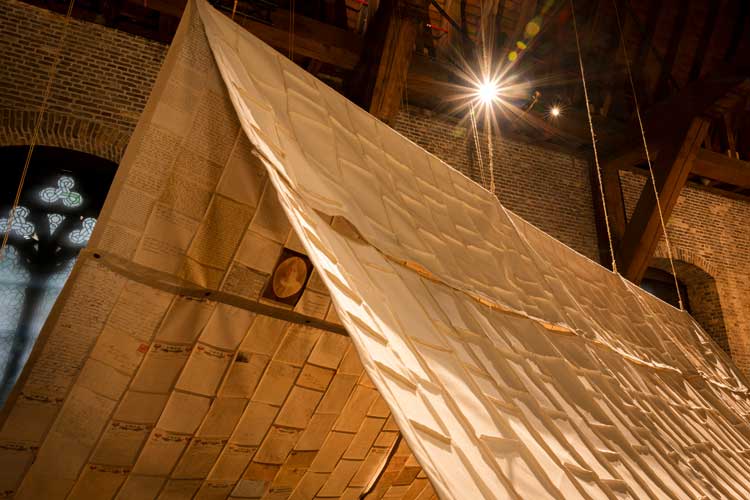
Selva Aparicio. If I write again, 2024. Installation view, In Flanders Fields Museum, The Cloth Hall, Ypres, Belgium. Photo: AS Deldycke.
VS: The residency is a wonderful legacy project for the museum, because it creates opportunities to reappraise or re-present parts of its collection. What did it represent for you?
SA: For an artist, it’s amazing to be allowed to go and look and find your own way in a collection of this size and quality. I’m sure I must have driven them crazy at times – why is she jumping from this to this? But in my head, it made sense. You’re connecting through your whole body of work, you want it to make sense for yourself, for the museum, for the context, everything together. It’s almost like a puzzle, it’s wonderful.
VS: Spending time in Belgium for these two commissions over this year must have given you a perception and insight into this place and its history. Is it the first time your work has engaged with specific war issues?
SA: In the war context, yes. I have worked a lot with mourning. It is my whole life. But in the context of war, it’s the first time.
After being in the US and coming to Belgium, it reawakened a sense of how history lives within the landscape and how literally that is something the US doesn’t have. I had a professor, 15 years ago, and we talked about the (importance of) language. I am originally from Catalonia, and my family is from the Basque country. The Catalan language has not been lost, but it is threatened. The professor said: “It’s very important to preserve the language because it is the echo of the landscape.” I thought that was very beautiful. And even if the language is only spoken by a few, it’s still very important. It’s the same with the history that is visible in the landscape. Doing the (war graves) tours here, you see that nature has appropriated now where a bomb was thrown. There are all these juxtapositions of terror and beauty that you don’t have in the US.
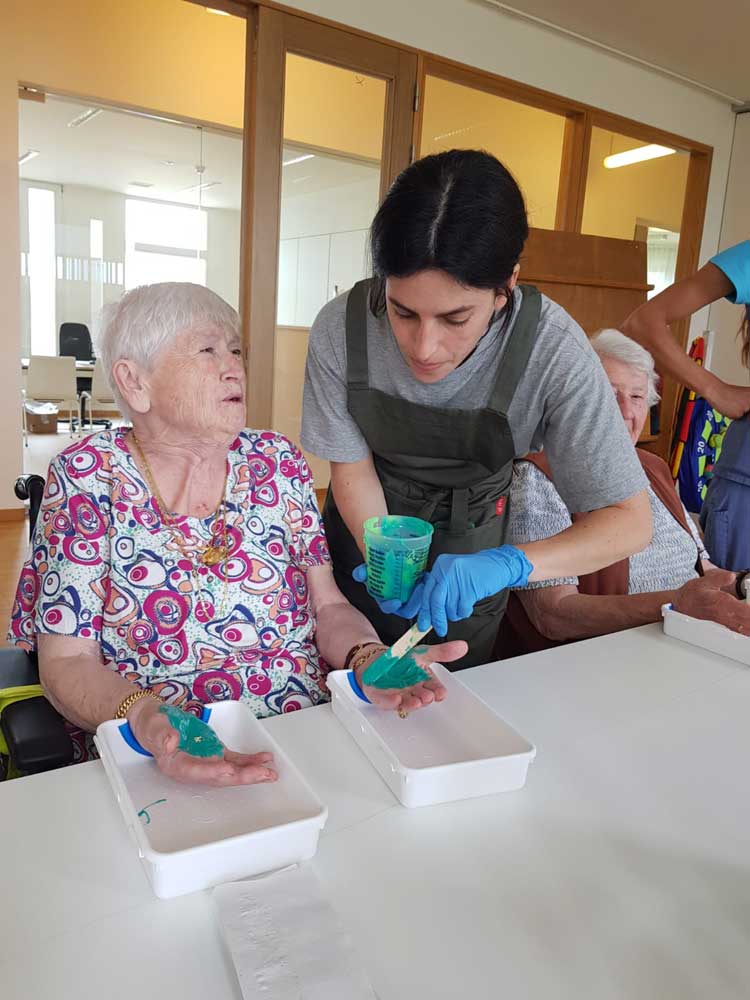
Selva Aparicio and participant at workshop for At Rest. Photo courtesy Selva Aparicio.
VS: Has the time you have spent here with these communities and collections enriched your sense of what it is your work does, and what it can activate in a specific place?
SA: One of my favourite parts of my work is collaboration. But it’s a strange sense of collaboration. When someone says collaboration, they are usually talking of a team thinking about an idea. But in this case, I have the idea, I collaborate with a community or in this case the museum, which helps to make the work happen. So, in a sense, they become part of the material of the work. They are part of the work literally. The first time this happened was in 2017. There was a terrorist attack in Las Ramblas in Barcelona. I had just arrived in Barcelona the day before. I turned on the news and saw that a van had attacked people in Las Ramblas. This van drove 500 metres and stopped right on the top of Joan Miró’s floor mosaic. I had the urge to go there straight away. I got there and tourists were running away, everyone was crying, it was like this horrible situation where everybody was trying to process something we are not wired, not trained to understand. Las Ramblas is one of the most touristic places I can think of. People from nine different countries died. It was like an international death. I went to the art store and bought lots of paper and graphite. I thought: I need to capture the physical history of this moment right now, this whole pattern, from the start to the end. I put one piece of paper on the ground – and the Ramblas tiles are iconic – I started rubbing the first tile and then I put another paper down, and I was getting stepped on, but I didn’t have enough time to think about it. It was instinctive. But at the same time (my response) comes from years of thinking on this topic.
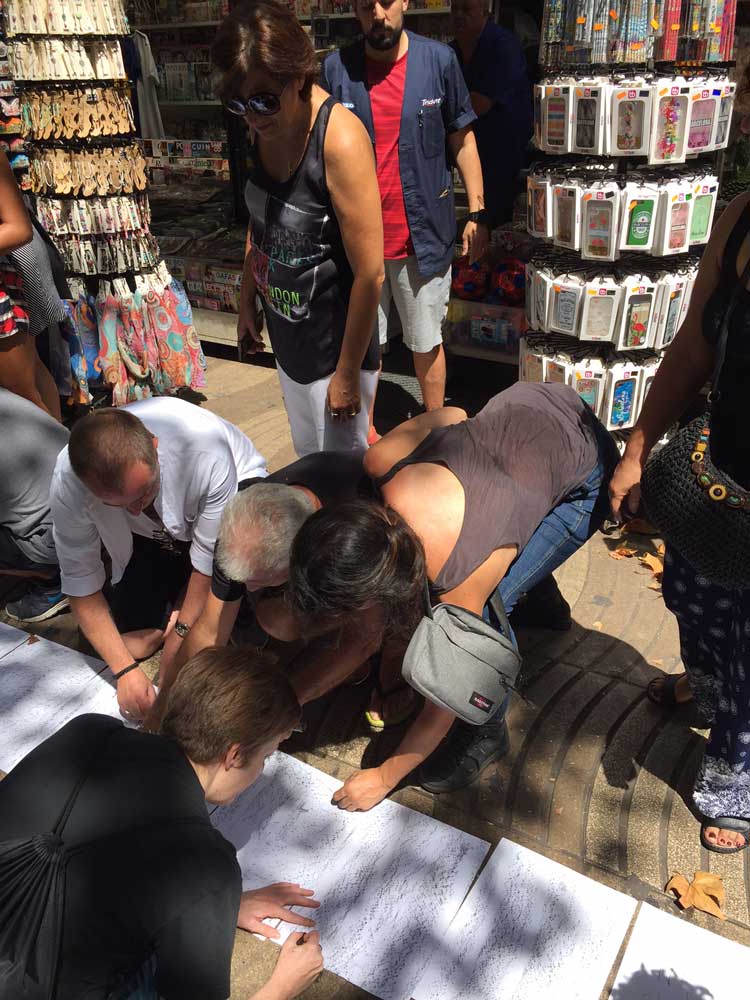
Las Ramblas, Barcelona, 17 August 2017. Photo courtesy Selva Aparicio.
And then, suddenly, after five pages or so, somebody bends down and says: “What are you doing? Can I help?” And then another person asks. And … suddenly I looked to my left – I thought I was going to be there for days – there was this whole chain of people bending down, rubbing, in silence. You could only hear scribbling. All the way from the beginning, it took us five hours. Some people stayed for one paper, some stayed the whole time. At some point people started leaving messages. There are many messages. Messages of peace, anti-terrorism, messages of children’s drawings which break your heart. And at the end, we had this pile of pages – 1,700 or more. It had the weight of a dead person. That’s how it felt. And everyone was hugging and crying. I wondered what was the piece? Was the piece this moment, with these papers? Or is it what I do afterwards with it? I have been thinking about this for many years since then. I finally shipped the papers to the US. I’m now finishing this piece. I am connecting all the papers into one whole huge roll, like a scroll. I want to make the core in glass, very fragile, that is holding all the weight.
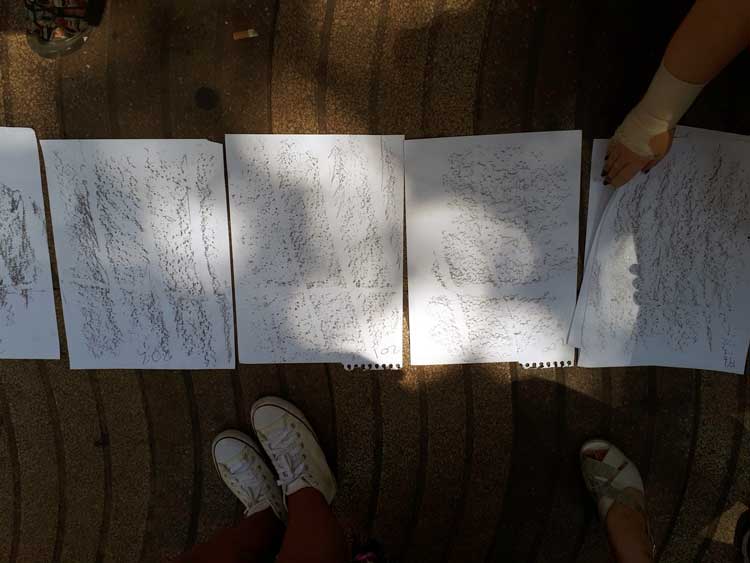
Detail of drawings for Las Ramblas, Barcelona, 17 August 2017. Photo courtesy Selva Aparicio.
I do consider my work collaborates a lot. Even when I am working with dead people, I consider that a collaboration. Because when you work with a piece of, I don’t know, a wasps’ nest, it’s not just a material. It’s a material that has a life of its own.
With the Beaufort piece, I did talk to people through the process of making the moulds, but it’s not really like a deep conversation, because a lot of them don’t speak English and I don’t speak their language. (Yet) when I saw these people visiting the At Rest work, I felt we understood each other. For me, that was the biggest reward. Because this piece has to be there for good. There was a huge sense of responsibility. Public art is very difficult to get right. Contemporary art can be very cryptic. For me, the best works of art are like onions, there are layers for everybody. If you want to peel more, you can go into the core but, if not, you can just sit on it, literally, in the case of Beaufort. (laughs).
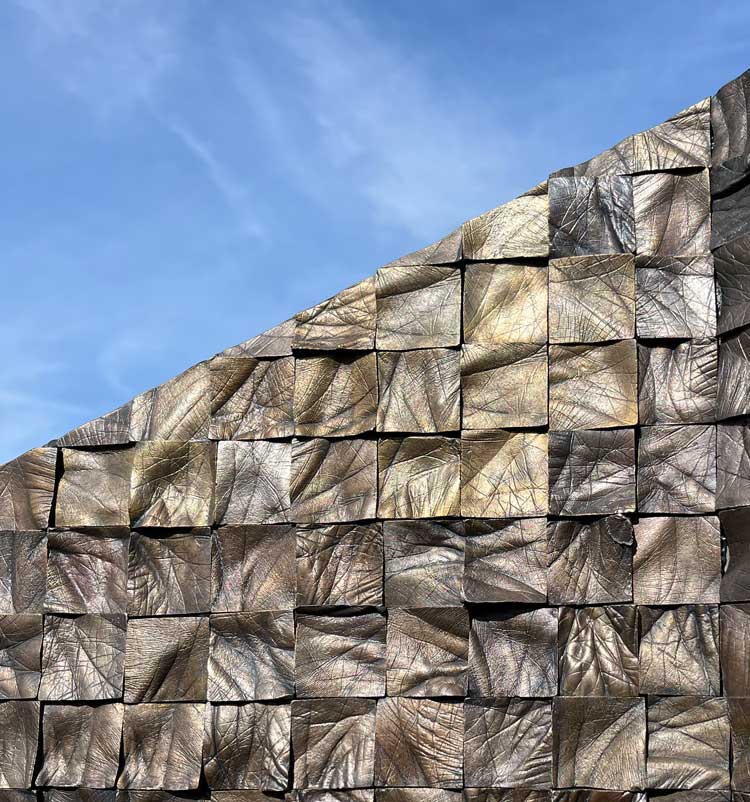
Detail of At Rest, 2024. Photo: Veronica Simpson.
VS: What are you working on next? You obviously have to go back to Alfred University and continue teaching.
SA: I want to finish some things that I haven’t had time to finish. Like the Las Ramblas work. I want to finish it and hopefully send it to Spain because I think that’s where it should live. I want to take a little time to digest everything that has happened up to this point. And I think it’s an important part of the process.
VS: It feels as if your work comes from a place of paying fierce attention to small details, looking for the things that connect us to our environment, our histories, and each other.
SA: Yes, but sometimes I say yes to deadlines so much that I don’t have time to process and digest.
My mother, who is here in Ypres, she knows that I have always fought so hard to make the work I want to make, which was not commercial at all, so it was really hard to survive. But in my mother, I had a great example of surviving and adapting. She’s very inspiring to me. When I was a teenager, I read this quote by Picasso - with whom I have a love/hate relationship; he’s a Spanish man, of his time. The quote is: “Painting is not made to decorate apartments. It’s an offensive and defensive weapon against the enemy.” After I read that, I painted my mother the whole of Guernica, life-sized, 8 metres by 4 metres on a wall in her garden, as a gift to her because she’s Basque. The Spanish civil war is still very raw in Spain. There’s still a lot of pain, bodies not found, and problems within families, like my own. There are still a lot of people who adore Franco. I think in that moment, when I was about 14 years old, that’s when I decided I really wanted to go to this art high school in Barcelona [the Escola Massana, where Aparicio studied for three years].
VS: Your commitment and dedication to the subjects that inspire you seem to be paying off now.
SA: Yes. I always thought that, since I was a little kid, I thought art was my career. It was very hard where I grew up. Nobody gave one cent for my future, except for my mother. There were not many resources. And my mother had a lot of difficulties - she had to raise three kids on her own. Maybe it was almost naive, but I had it so clear all my life. I knew I had no option. I always thought I’m going to live off my work and I’m going to buy my mother a washing machine.
VS: Has that happened yet?
SA: Oh yes. And more. I had so many people in my life I was able to learn from that, by the time I was in art school, I was way beyond because of all these encounters. I felt I had an advantage. And I was grateful for that too.
• Selva Aparicio: If I Write Again is at In Flanders Fields Museum, The Cloth Hall, Ypres, Belgium, until 5 January 2025.